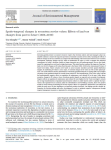Schirpke U., Tscholl S., Tasser E. (2020). Spatio-temporal changes in ecosystem service values : effects of land-use changes from past to future (1860–2100). Journal of Environmental Management, 15/10/2020, vol. 272, p. 1-12.
https://doi.org/10.1016/j.jenvman.2020.111068
https://doi.org/10.1016/j.jenvman.2020.111068
| Titre : | Spatio-temporal changes in ecosystem service values : effects of land-use changes from past to future (1860–2100) (2020) |
| Auteurs : | U. Schirpke ; S. Tscholl ; E. Tasser |
| Type de document : | Article |
| Dans : | Journal of Environmental Management (vol. 272, 15 October 2020) |
| Article en page(s) : | p. 1-12 |
| Langues : | Anglais |
| Langues du résumé : | Anglais |
| Catégories : |
Catégories principales 07 - ENVIRONNEMENT ; 7.4 - Ressources Naturelles : Paysage, Biodiversité, Patrimoine naturelThésaurus IAMM SERVICE ECOSYSTEMIQUE ; UTILISATION DES TERRES ; GESTION DES RESSOURCES NATURELLES ; CARTOGRAPHIE ; SCENARIO ; REGION D'ALTITUDE ; PRAIRIE ; ADAPTATION ; DEVELOPPEMENT SOCIOECONOMIQUE ; PRISE DE DECISION ; HISTOIRE ; PROSPECTIVE ; ITALIE |
| Résumé : | Increasing global pressure on natural resources requires that decision makers and land managers adopt sustainable solutions to ensure the long-term provision of essential ecosystem services (ES). Analysing the effects of land-use changes on ES can contribute to an improved understanding of the interactions between socio-economic development, landscape changes and ES, which is fundamental in order to avoid or mitigate the undesired consequences of today's decisions. Studies at longer timescales are still underrepresented, but are also fundamental for capturing slow social and ecological processes. This study therefore analysed the impacts of land-use/land cover (LULC) changes on ES values from the past to the future (1860–2100) in the Autonomous Province of South Tyrol (Italy). Future scenarios were based on socio-economic storylines and their spatial distribution mapped. By attributing ES values to LULC types, we assessed changes in ES values as well as their spatial patterns. Our results indicate that the abandonment of mountain grassland induced an ongoing shift in ES at higher elevations, from grassland-related ES towards forest-related ES. The intensification of use in the valley bottoms had predominantly negative effects on regulation & maintenance, and cultural ES in the past. Under future scenarios, changes in ES values at lower elevations greatly depend on expected socio-economic development. Negative effects on regulation & maintenance and cultural ES were highest for the ‘Food sovereignty’ scenario due to huge transformations of grassland and permanent cultures to arable land in order to optimise food provision at the regional level. In contrast, under the ‘Liberalisation’ and ‘Rewilding’ scenarios, there were positive trends for forest-related provisioning ES and less negative effects on regulation & maintenance and cultural ES within the study area, but the dependence on imported products increased. Our findings provide valuable information for decision-making and policy development in order to minimise negative consequences through targeted management measures or payments for environmental services. |
| Cote : | Réservé lecteur CIHEAM |
| URL / DOI : | https://doi.org/10.1016/j.jenvman.2020.111068 |







